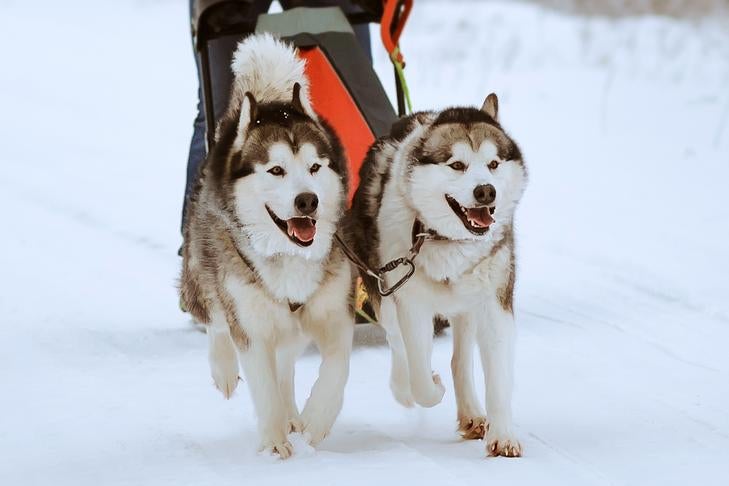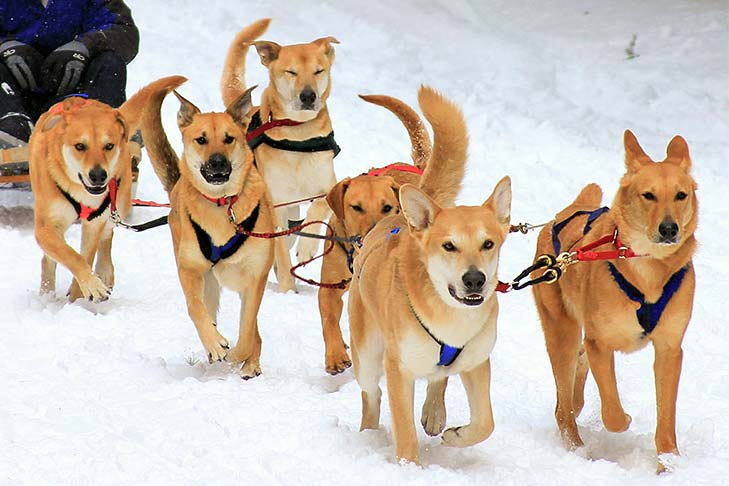
What does it take to run hundreds of miles across packed ice and frozen terrain, for days and weeks on end, in arctic temperatures? That’s easy — a lot. A lot of grit, guts, and a laser-like focus on getting where you’re going, and sled dog breeds have these qualities by the sled load.
What Breeds Make the Best Sled Dogs?
The Samoyed, Alaskan Malamute, Siberian Husky, and Chinook are some of the most well-known of the sled dog breeds. Sled dogs probably evolved in Mongolia between 35,000 and 30,000 years ago. Scientists think that humans migrated north of the Arctic Circle with their dogs about 25,000 years ago, and began using them to pull sleds roughly 3,000 years ago.
There were two main types of sled dogs. Coastal cultures kept one type of sled dog, while people living in the interior kept another. In the mid-1800s, Russian traders following the Yukon River inland acquired sled dogs from the villages along its shores.
The Era of the Sled Dog
The first formal sled dog race wasn’t held until 1850. The race ran from Winnipeg, Manitoba, to St. Paul, Minnesota. But sled dogs’ place in human history goes back thousands of years and served a much greater purpose than simple entertainment.
Sled dogs served as a primary means of communication and transportation in harsh weather conditions. Some scholars, in fact, believe that human survival in the Arctic would’ve been impossible without the assistance of sled dogs.

Sled dogs played important roles in many significant moments in history. The late 1800s and early 1900s were even nicknamed the “Era of the Sled Dog.” A few notable moments involving sled dogs over the last two centuries include:
- During the Klondike Gold Rush at the end of the 19th century, sled dogs transported everything from prospectors to supplies to mail. Jack London immortalized this in his legendary novel “The Call of the Wild.”
- During Roald Amundsen’s 1911 South Pole expedition, the great Norwegian explorer used sled dogs (something he’d learned from the Inuits during a previous exploration of the Northwest Passage). Amundsen beat rival Robert F. Scott to the South Pole. Many credit his success, in part, to the use of sled dogs.
- During the 1925 diphtheria outbreak in Nome, Alaska, 20 teams of sled dogs transported a vital anti-toxin to the ailing members of the town. They traveled almost 700 miles in the span of six days.
The Development of Mushing
After that, these hearty breeds worked at a variety of jobs, until airplanes, highways, trucks, and snowmobiles effectively put them out of work. (Sled dogs today are still used by some rural communities, especially in areas of Alaska and Canada, and throughout Greenland).
But they didn’t stop mushing (another name for racing) once their jobs dried up. Sled dog breeds and their outdoorsy owners mush for recreational purposes, and the fanatically devoted teams participate in events like the Iditarod and the Yukon Quest. Billed as the “World Series of mushing events,” the Iditarod is 1,100 miles of sheer endurance, spanning about 10 or 11 days, depending on the weather.
It begins with a ceremonial launch in Anchorage, Alaska, the morning of the first Saturday in March, with mushers running 20 miles to Eagle River along the Alaskan Highway, giving spectators a chance to see the dogs and their mushers. The teams are then loaded onto trucks and driven 30 miles to Wasilla for the official start of the race.
Famous Sled Dogs
Perhaps the most famous sled dog of all was Balto, a jet-black Siberian Husky. He was the lead dog of the team that carried diphtheria serum on the last leg of the relay to Nome during the 1925 diphtheria epidemic. There was serum in Nenana, but the town was 700 miles away, and inaccessible except by dog sled. A relay was set up, and 20 teams pulled together. Six days later, the lifesaving serum reached Nome.
In 1995, Universal Pictures released the movie “Balto,” based on his life. It earned three out of four stars from the most famous film critic of the day, Roger Ebert. Today a bronze statue in Balto’s honor stands in Central Park.

While the lead dog of the 53-mile final leg, Balto, would become famous for his role in the run, many argue that it was Siberian Husky lead dog, Togo, who was the true savior of the day. All told, the 12-year-old Togo traversed an astounding 264 miles, compared to an average of 31 miles each for the other teams.
Over time, with the help of historians, Togo began to garner the recognition he deserved. In 2001, Togo received his own statue in NYC’s Seward Park. In 2019, his story was retold in a Disney+ movie called “Togo.” The film starred Togo’s own descendant, Diesel, as Togo himself.
What Makes a Good Sled Dog Today?
Although sled dogs are still used for transportation in some rural communities in Alaska, Canada, and Greenland, their main role now lies in mushing. The Yukon Quest — a race from Whitehorse, the capital of Canada’s Yukon territory, to Fairbanks, Alaska (considered even more challenging than the legendary Iditarod) — are two of the most popular mushing events, but there are dozens of events in the United States alone every year.
A musher looks for several qualities in a good sled dog. One of the most important is good feet. Long-distance races are tough on a dog’s body, and the feet bear the brunt of the work. Dogs with tender feet may not do well on the trail, even with booties, and professionals point out that booties slow dogs down in shorter races.
A healthy appetite and a thick coat are also important. Picky eaters might not take in the necessary calories on the trail, which reduces their performance ability. A healthy coat with a thick undercoat helps keep a dog warm and protected from the elements and preserves those essential calories.

You can train your dog to peak physical fitness, but a desire to run and work in harness is equally crucial for a team’s success. Mushers look for dogs that love to work in a team with other dogs and with the musher. Antisocial or aggressive dogs aren’t the right fit for this sport, and many sled dogs interact with fans and tourists year-round. These dogs need to be friendly toward people and confident in new situations.
Sled dogs might love to work, but perhaps their most important job today is education. “These dogs, even though they don’t speak, manage to communicate to our visitors about the importance of wild spaces,” says Jennifer Raffaeli, the manager of Denali National Park Kennels. Our modern lifestyles separate many of us from the outdoors, and sled dogs are a way for us to reconnect with the natural world.
How Can I Get Involved With Sled Dogs?
Lessened interest isn’t the only challenge in sled dog mushing events. Climate change is impacting today’s sled dogs in the biggest way. The lack of snow and ice is forcing race cancellations and changes. In fact, the two areas in Alaska where the majority of the Iditarod takes place — the Central Interior and the West Coast— are experiencing some of the fastest-rising temperatures in the state.
With these changes comes the increased closure of sled dog companies and the need for new homes for these dogs. While some mushers believe that sled dogs don’t make great pets — they point to challenges in house training, walking on a leash, and separation anxiety — others argue that if you approach them with the same patience and willingness to train that you would approach a puppy, a sled dog makes for a very good companion.
If you want to get more involved with sled dogs or sled dog breeds, look for a local sled dog racing club in your area. You might be surprised to find out just how many are out there, even in warmer climates. You can also get in touch with racing kennels and breed enthusiasts for more information about sled dogs and racing for beginners.

